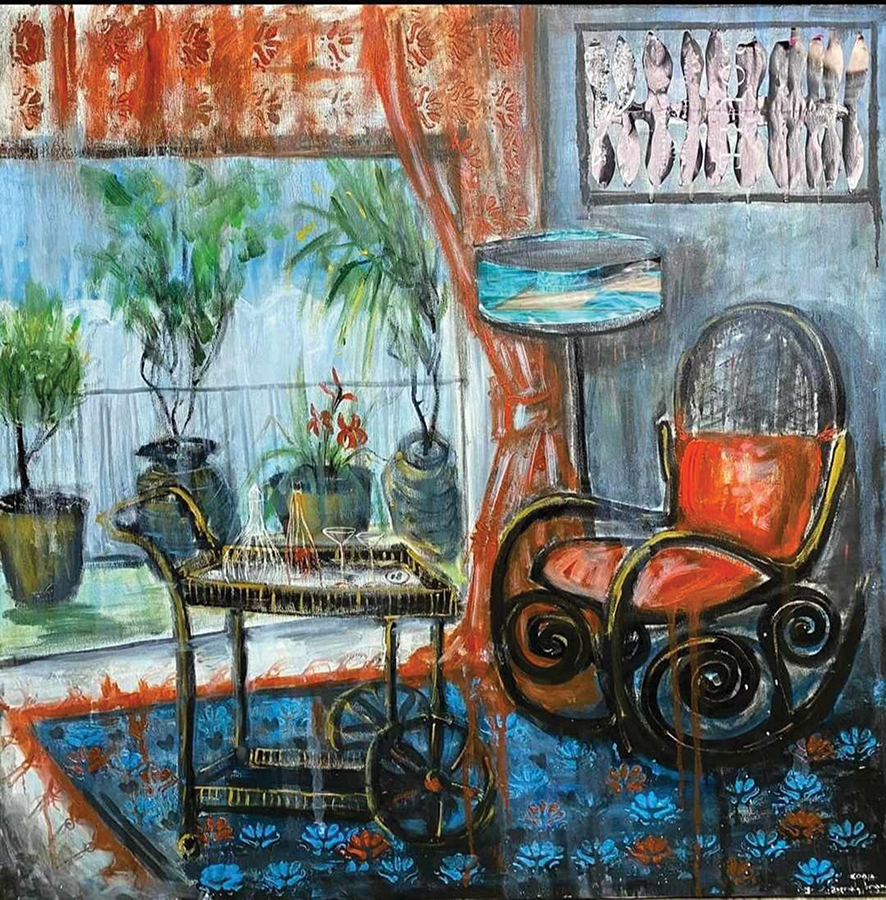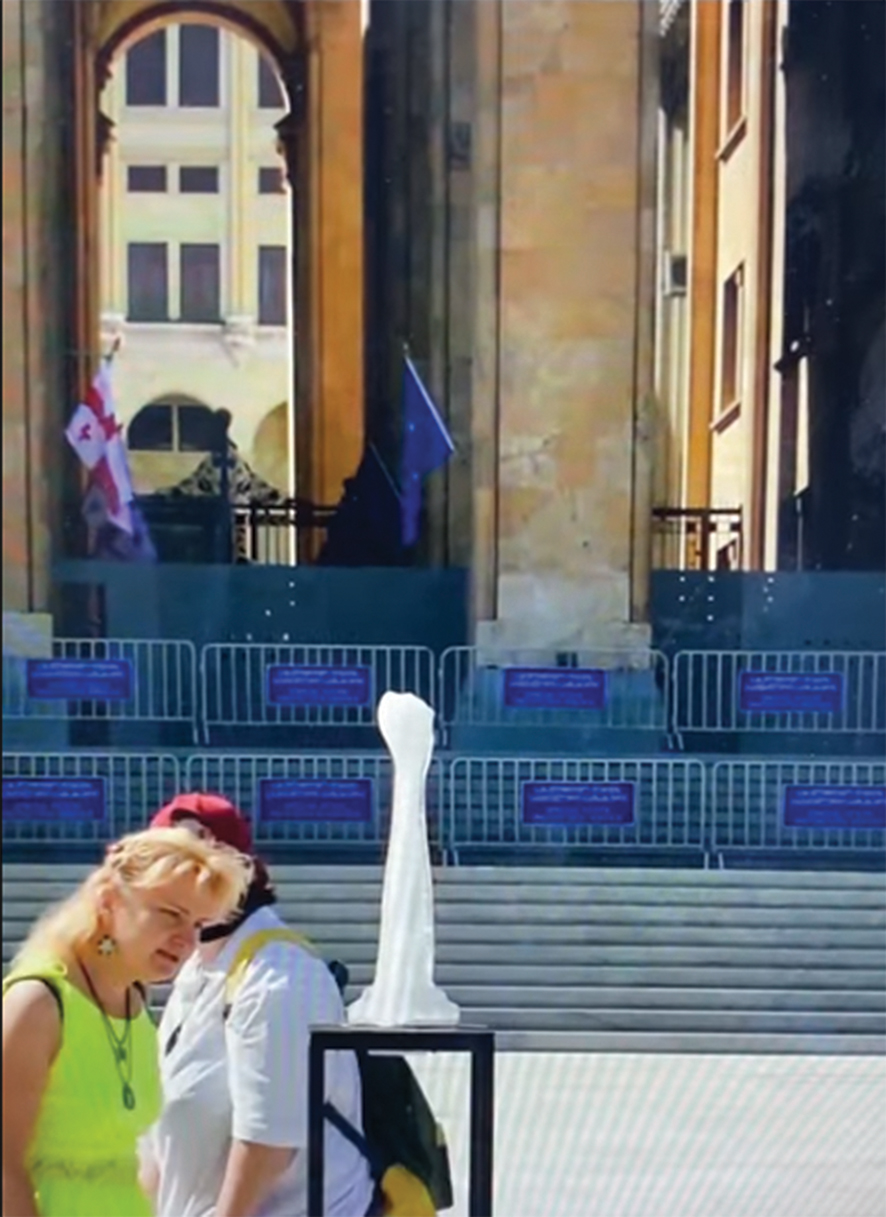May 2024 was marked by massive demonstrations in Tbilisi against the notorious “Foreign Agents Law” that was approved by Parliament in spite of all the local upheavals and international outcry. With all this in mind, the Maikunst Festival of Georgian artists in Volkssolidarität Berlin, within the Art in Public Spaces Project framework, acquired a whole new meaning, questioning the role of art in times of crisis, and its ability to cause change.
Andro Dadiani’s video “Fist” (Mushti), made a couple of years ago and screened during the opening reception, offered an ironic and bitter comment about the futility of protests and the failure of arts to effectively intervene in political processes. His short film recording an allegoric gesture of protest – a fist made of ice that gradually melted in the heat – used as its setting the very square in front of the Georgian parliament building that for decades has been the site of protests of the population against all sorts of injustices and hardships taking place in the country. Yet, like the recent protests against the controversial “Agents Law,” most of the demonstrations remained mere gestures of public disobedience and a pathetic movement causing little actual transformation.

It has not been the purpose of the Maikunst Festival to involve itself in the political affairs of Georgia, but rather to focus on the arts and crafts from the country, to make visible the work of the exceptionally talented contemporary Georgian artists based in Tbilisi, giving them a chance to present their current artistic practice, creative aspirations, and the inspiration that they take from the centuries-old Georgian traditions of arts and crafts, as well as influences of European modernism.

One of the best examples of the longevity of traditional Georgian handmade art is evident in the artworks and design items made of teka-fabrics by Khatuna Kobeshavidze. Her teka pieces with floral compositions combine a variety of textiles and cloths, arranged in intricate sequences and patterns. Some inspired by subtle color gradations, others by motives invoking Picasso‘s cubist compositions, show the artist’s skill, craftsmanship and passion for experiment. Her recycled Teka bags are stylish and practical for daily use.
Design and innovation bringing together art and fashion are signature trademarks of Tata Veltauri who exhibits a set of hand-painted gender neutral wearables for young and old. Her special technique of color application on fabric is unique, and her motives from art history, ranging from Gustav Klimt’s iconic motives to pop culture imagery, make her outfits spectacular and eye-catching. Slogans and citations in Georgian letters hand-written on fabric by the artist, who uses special water-proof color pigment, look ornamental and enigmatic, making outfits by the VELTAURI brand timeless and contemporary at the same time.
Jewellery by Georgian artist Natka Davitelashvili presented at the exhibition is made of precious stones and minerals. The pieces exude a polished and shimmering allure, combining raw beauty with artistic skill. Beads, bracelets and earrings featuring animal motifs capture nature’s elegance, creating unique and vibrant pieces that reflect both the wearer’s style and a connection to the natural world.

Further on, the show features numerous contemporary Georgian painters: Vaxo Saladze for one. His oil on canvas paintings, executed with an experimental mixture of pigments, showcase a masterful blend of figurative motifs and non-figurative abstract styles. The intricate compositional setup invites viewers into a dynamic visual experience, where recognizable forms seamlessly merge with abstract elements, creating a rich tapestry of color, texture, and form.
Mariam Kandiashvili’s paintings of urban landscapes capture the mundane yet evocative scenes of roundabouts, car washes, and factory buildings piping chimney smoke. The grey skies and winter days set a melancholic tone, highlighting the stark beauty and raw reality of everyday life. Through their detailed depiction of trivial settings, these works invite contemplation on the overlooked aspects of our urban environment.
Sopo Koridze’s large-scale canvases blend figurative elements with delicate colors and flowing forms, creating a harmonious fusion of environments. Their poetic aura invites viewers into a dreamlike space, where the interplay of light and shadow evokes a sense of tranquility and introspection. The artworks’ expansive nature and subtle details offers a meditative experience, celebrating the beauty of both the natural world and human imagination.
Sophia Beltadze’s small yet dense oil-on-canvas paintings deal with the topic of “home sweet home” depicting the interiors of dwellings in somber tones of reds and blues, with isolated furniture pieces: Armchairs and lamps being the usual settings of average apartments, obvious symbols of cosiness. The intimate scale and rich details evoke a sense of solitude and introspection, highlighting the quiet, contemplative moments within domestic spaces.
Ketevan Kharaidze’s mountain landscapes depict the Caucasus rocky horizons with towers beautifully fitted in. Her nature-mortes feature flowers, such as chamomile flowers, arranged in vases with contrasting backgrounds. The delicate white petals of the chamomiles stand out vividly against the black backdrop, and lilacs in a white vase add a touch of elegance and simplicity. The compositions highlight the beauty and purity of the flowers, creating visual harmony.
Arsen Gvenetadze’s small sculptures are characterized by their rounded, organic forms and vibrant colors. They feature repeating patterns inspired by the human body, evoking a sense of harmony and fluidity. The playful shapes and bright hues bring a lively and dynamic presence to the pieces, “celebrating the joys of existence,” as he puts it.
Ketevan Gibradze’s artworks feature figurative motifs such as pomegranates and train wagons. The pomegranate pieces capture the fruit’s rich symbolism in oriental cultures e.g. allusions to wisdom and fertility, while the series with trains, crafted from copper and applied to media surfaces, juxtaposes industrial elements with the vividness of acrylic paints. Both sets of works offer a unique interplay between the organic and the mechanical, exploring themes of nature, industry, and transformation.

Painters Luka Manjgaladze, Luka Abazashvili and Salome Durglishvili deal in their highly poetic and allegorical works with philosophical existential questions of being, truth, reality and dreams – all rendered in rich, sumptuous colors of blues, blacks and purples adding to the emotional intensity of the pictures. Surreal landscapes, abstract color combinations and mysterious lonesome figures set into the pictorial compositions leave the viewers wondering and uneasy.
Salome Kikvilashvili researches in her series of paintings dedicated to spirits the romantic fairy-tale worlds inhabited by magic animals, gloomy trees and mysterious plants, abandoned dreamy urban structures and rocky surroundings reminiscent of the surrealists‘ visions and painting style. The female figure in the foreground, probably the spirit itself, ushers the spectators into the imaginary worlds rendered on her canvases.
Painter Nino Kurashvili, a former student of world famous artist Friedensreich Hundertwasser, is represented by two works ‘Fish’ and ‘Cosmo Woman.’ The shimmering gold-covered surface of her paintings appears enigmatic. The dark contours of the female figure with a helm stands out as if performing a ritual dance movement. Her dark profile accentuated by the hand pressed to her forehead shows the flow of the moment and the state of meditation. The golden fish, on the other hand, against the dark background, evokes fairy tale motives from folklore and legends, calling into memory the supernatural powers invested in animal totems and christian symbols.
In times of crisis and political instability, many artists opt to escape into the surreal worlds of phantasies and blissful contemplation. Others decide to interpret reality in their artistic practice in the form of political activism, some artists making use of politically charged symbols in their works that bring their message across to the viewers better than words. Art is a medium that appeals to human emotions in the first place, to our hearts rather than to our minds, standing above political agendas and ambitions. Artists are free to choose between creating overtly political content or seeking inspiration from other topics. The idea of this exhibition was to document current artistic trends in the contemporary Georgian scene and design. The exhibition of Georgian artists at the Volkssolidarität Berlin is curated by Lily Fürstenow. Due to the increasing interest of the viewers, it has been extended till June 30, 2024. More information is available online on the virtual art platform: www.e-mergingartists.art
By Lily Fürstenow














